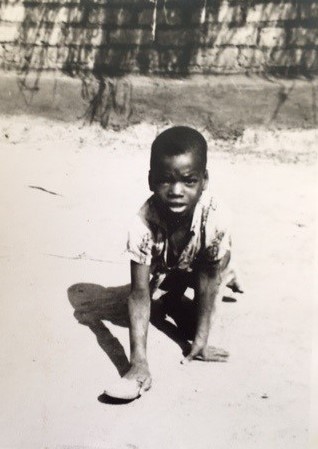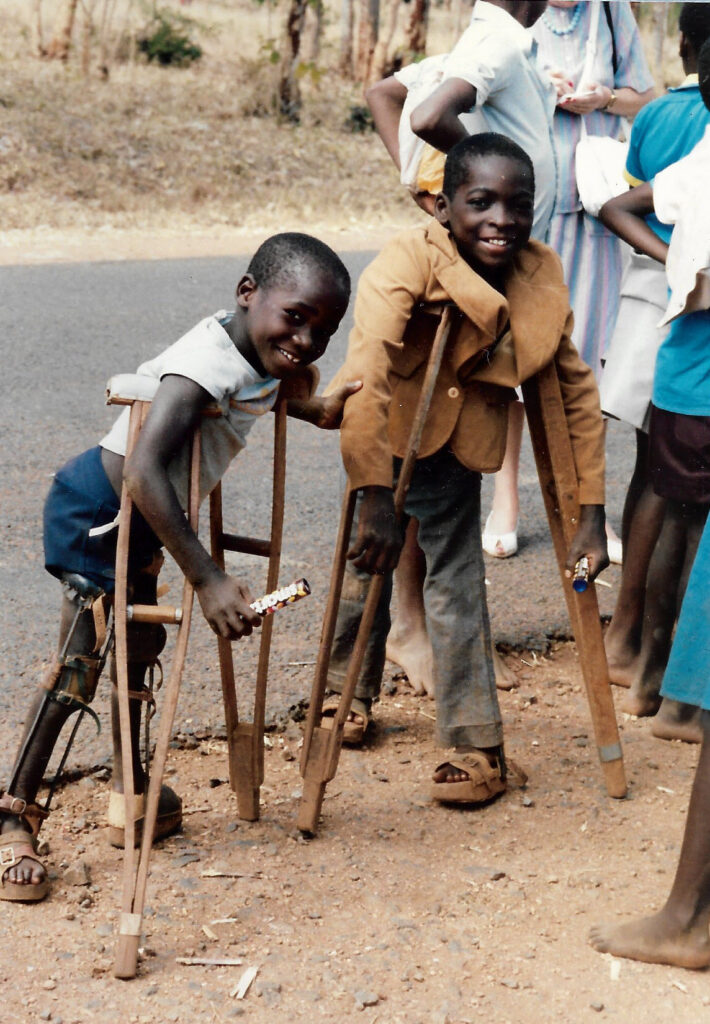Malawi Against Polio (MAP) – was conceived in the hills behind Mangochi in July 1977. Ibrahimu, aged 15, had crawled half-a-mile on hands and knees to be confirmed. He was completely normal except that he had never been able to walk because one leg stopped short at the ankle. Each week he had crawled half a mile to attend his confirmation class.
A simple operation and a cheap peg-foot were all he had ever needed for 14 years to enable him to walk. But such things were not available in the remote Muslim village where he lived.
I was angry with his father and asked him why he had not tried to get medical help. “Ever since he was born, each time I come home from the Copperbelt in Zambia I carry him fifteen miles to Mangochi Hospital. Each time they say, ‘Go home and wait till you are called.’ But they have never called me.” On the previous day at each of two confirmation services a girl had been carried up for the laying-on-of-hands. Both were paralysed as the result of polio, their legs useless bent sticks.

Jan Borgstein and understanding the challenge
A few days later, still angry, I met Jan Borgstein, the Dutch senior surgeon in Malawi, at a reception on State House lawn. “Why are you doctors doing nothing about polio?” By the time we had finished talking we had agreed that Jan would look after the surgical side and that I would organise a small survey to make a case for action. How big was the problem? No one had any idea, though motorists knew that quite often they would have to slow down to allow a girl or boy to shuffle across the road on their hands and bottoms.
We decided on a sample survey of those within reach of the 70-mile road from Malosa to Malindi on the eastern lakeshore, with a detour to include Balaka. Letters were written to the few schools we knew of within reach of the road, asking for children with these problems to be brought on Saturday, 26 November 1977, to the roadside or to one of the schools, churches or health centres on the route that we intended to follow. We hoped that we might see perhaps a hundred youngsters.
We began at St Luke’s Hospital where there were 50. At Liwonde there were 60 and we decided to divide into two groups, one doing a detour to Balaka, the other carrying straight on. Some came crawling, some were carried, some on the backs of bicycles, some hopping on poles. None of us had ever seen so much needless suffering on any one day. Needless, because all the polio could have been prevented by three doses of vaccine and all the clubfeet could have been straightened while the children were still babies.

It took three Saturdays to complete our mini-survey. 500 youngsters with such problems had come to the roadside or to one of the health centres on our route, not counting another 60 who were blind or arthritic. Jan Borgstein’s plan had been to give up his Saturdays to operate on those affected at St Luke’s or at another hospital on the route. This would hardly make a dent in the problems the survey had revealed. There was no orthopaedic surgeon and only one physiotherapist in a country four times the size of Wales.
I wrote at the time in the Diocesan Newsletter:
“The good news is that nearly all the hundreds who came hopping on one leg, crawling or carried can even now be put back on their feet. Whose fault was it that this was allowed to happen? Nobody’s.
Whose fault if this goes on? Ours. If you are a leader in the church, please tell your people – “Polio can be prevented, club-feet can be straightened, crippled children can learn to walk again. If you earn more than the average wage or live overseas please help us to buy the vaccine and the leg-irons. If you happen to be a physiotherapist or an orthopaedic surgeon we can think of lots you can do so that all of Malawi’s children can go “walking and leaping and praising God” like the man Peter and John healed in the temple. You can read that story in Acts chapter 3.”
Ron Huckstep
An SOS was sent off to Save the Children and other agencies. Jan told us of an orthopaedic surgeon in Sydney called Ron Huckstep who had been interned in China as a child and had his first informal lessons in medicine while in prison. More recently he had headed a campaign against polio in Uganda. Having been trained as an engineer before becoming a doctor he approached problems as an engineer. Currently the only way of getting a pair of calipers was to visit the Queen Elizabeth central hospital in Blantyre. He would measure the child, who would then return home and report back a month later for a fitting. The Huckstep approach was to see that every rural clinic in Malawi had a stock of wooden calipers of different sizes.
Huckstep had visited Malawi some years earlier, but there was then no political will and nothing happened. This time he was more subtle. President Banda had recently made a large donation to the Royal College of Surgeons in Scotland, where he had trained as a doctor; in return they had made him an honorary Fellow. Huckstep arranged to collect his medal in Scotland and bring it with him to Malawi. This gave him instant access to the Head of State instead of the usual month’s delay. He was rewarded with the promise of an hour’s broadcasting time each week on Radio Malawi, and the support of the chairman of the Malawi Congress Party in every village in Malawi who now had more power than the chiefs.
In his ten days with us Ron Huckstep visited the North to see the problem in remote village areas and held a non-stop seminar in Blantyre from Friday morning to Sunday night. This produced an action plan and more importantly, backing from every section of the community. It was resolved to form MAP – Malawi Against Polio. Miss Cecilia Kadzamira, President Banda’s official hostess, was elected into the chair, Dr Jan Borgstein as medical adviser and myself as secretary. Now we had at least a framework but still no funds. I was asked to send an appeal to every charity I could think of.
Rotary donates money to kick off MAP
One of the reports was sent to my brother Felix in Queensland. When he had arrived 35 years earlier as head of the Brisbane Children’s Hospital, he was the only paediatrician in Queensland and the Northern Territory. He had been involved in public controversy about the treatment of polio and had visited us in Malawi more than once. What none of us in Malawi knew was that Clem Renouf, the new head of Rotary’s world-wide programme for Health, Hunger & Humanity was a personal friend of Felix. He also had a problem: six million dollars in a bank in New York and no idea of how to spend them. Felix showed my letter to Clem with dramatic results. Funds quickly became available and a succession of orthopaedic surgeons came to Malawi and passed on their skills to clinical officers and nurses. World Orthopaedic Concern, founded by Arthur Eyre-Brook, an orthopaedic surgeon from Bristol, who visited Malawi, enabled his retired colleagues to teach their skills where they were desperately needed.
Michael and Elspeth King’s Medicine and Disease in Malawi records that in the first two years after MAP was formed 21,167 patients with polio, clubfoot and other kinds of trauma were seen. 572 operations had been carried out, many by visiting volunteer surgeons, and 18,000 appliances issued, all made in four MAP workshops.
Jan Borgstein, who had inspired the whole campaign and whose dedication was total, saw none of the results of his vision. As I was flying back from Colorado in June 1979, Jan died of a heart attack climbing the 10,000-foot Mulanje Mountain. A message from his wife Ankie Borgstein was waiting for me asking if I would conduct his funeral, but please without any religious reference as he was an atheist on principle. I forget exactly what I said but in my mind was the reply Jesus made to his disciples when they told him they had stopped a healer from working because he was not ‘one of us’: “He that is not against us is for us”, Jesus told them. Six of Jan and Ankie Borgstein’s seven sons have become doctors, including Eric who is now Professor of Surgery at the Queen Elizabeth Hospital where Ankie still works part time as paediatrician.
The campaign spread to other developing countries and was broadened to cover other contagious diseases. In 1985 Rotary reported that since 1979 their Health, Hunger and Humanity programme had assisted 70 new long-term projects in 43 developing countries at a total cost of 21.4 million dollars. 49 million doses of polio vaccine had been administered.
Michael King followed Jan Borgstein as senior surgeon. The book The Story of Medicine and Disease in Malawi published by him and his wife Elspeth includes a photograph of sixteen children on crutches going to school from the Rumphi clinic, started by Gwen Gibbs in 1978. Gwen was a do-it-yourself missionary physiotherapist who began the work of MAP at Lilongwe and then moved on to Rumphi in the northern region. Supported financially only by her mother in North London, she built and ran a hostel for thirty disabled school children before moving on to work with leprosy patients in Tanzania, where she later died.
One of my first pleasures when we moved to Uxbridge in 1981 was to meet with a local doctor, Paul Binks and his wife Margaret, who had worked with MAP in Malawi for a number of years. They were both Rotarians and, although Margaret had developed terminal cancer, had decided to return to Malawi in joint service to children with polio.
In 1996 Chris Lavy, now professor of orthopaedics at Oxford, decided with his wife Vicky who was a GP to work in Malawi for four years. He wrote:
“Many people ask why we went. We could give a spiritual answer about going where God guides – and that would be true – but the simplest answer would be that we were needed. The 12 million people in the Greater London area had 200 consultant orthopaedic surgeons. Malawi, with the same population, had none. We planned to stay for four years but after six we were building Malawi’s first orthopaedic hospital in Blantyre and I had to stay to see this through. Before we knew it we had been in Malawi for ten years and had three children. That hospital is now the Beit CURE international teaching hospital with 66 beds specialising in treating the orthopaedic needs of children and adults.
Was it worth it? I saw and operated on thousands of patients, ranging from wild animal trauma to untreated club-foot so severe that the patients’ soles were facing the sky as they walked. I saw children with legs so bowed that their buttocks touched their ankles, and spines so twisted that their chest and pelvis faced different directions. They seemed happy as they went cheerfully away after the operation with the bent part generally straighter than before. Only the long term will tell whether the benefit was lasting.”
Thanks to massive efforts by official institutions and Rotary International, polio in 2013 is found in only five countries – Kenya, Nigeria, Afghanistan, Pakistan, Somalia. More than two billion children have been immunized since 1988, with the co-operation of twenty million volunteers and international funding of the order of $3 trillion.
